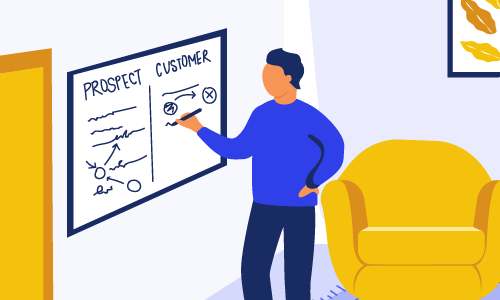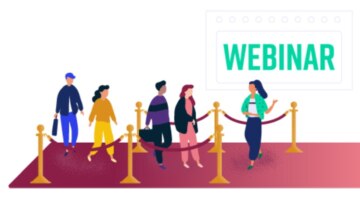B2B marketers have been talking a lot about hybrid events lately. And it makes sense why: marketers have found that virtual events are actually great for ROI, so they want to combine the benefits of digital events with in-person experiences.
We’re big fans of hybrid events because they optimize the attendee experience by providing personalized, on-demand content to enrich an in-person experience.
Marketing + Sales = Your team’s next revenue superpower. Learn how expert marketers bring the two together and drive results in our B2B Trends panel. [Watch Now]
But what should you do after the event is over? How does your organization follow up with attendees and registrants?
Like any traditional in-person event, the follow-up procedure should include both your sales and marketing teams. Hybrid event follow-up requires a slightly different sequence of events but the objective is the same: to move warm prospects closer to the conversion point in the buyer’s journey.
We’ll talk about what to do once a hybrid event is over, the difference in follow-up between traditional and hybrid events, and how to create buy-in from your sales team to do their part with follow-up.
What To Do When Your Hybrid Event is Over

It’s your job as a marketer to host and promote your company’s hybrid events. However, to round out the event lifecycle and capture ROI, the task of follow-up should be shared by your marketing and sales teams.
Once an event is over, marketing should email the on-demand recording to both event attendees and registrants who did not attend.
The on-demand recording should then trigger an email nurture program that includes drip feeding relevant resources to attendees and registrants. At this point, you can start to segment your attendee list further. A useful way to start is by segmenting booth visitors so that you know which attendees were interested in which services or products.
While your marketing team is following up via email with relevant resources to attendees and registrants, your sales team should begin their follow-up sequence as well.
It’s important that your sales follows up individually with everyone who attended the event, visited booths, and requested demos or other information. Since the touchpoint from marketing will be an email, it’s best for sales to make these connections via a phone call or virtual meeting.
Two Challenges Sales Face in Hybrid Event Follow-Up
There are two common challenges that sales teams face that can prevent them from executing a great follow-up campaign.
1) Lack of context or insight on the event
It’s critical that your marketing (and/or events team) thoroughly onboard your sales team before the hybrid event. They should also be debriefed afterwards.
When your sales team is clear on the primary goals, target audience, key takeaways and CTAs from the event, they’ll be able to optimize their follow-up conversations.
On the other hand, when your sales team doesn’t know why the event was important, that personal touchpoint is dulled.
2) No engagement data being tracked
An “in the dark” sales team makes for a bad follow up experience. To get around this, you’ll need to provide your sales team with engagement data collected from the event.
Ensure you have a system for tracking how attendees engaged at the event. The follow-up call should stimulate prospects, maintain momentum to keep the lead moving forward in their buyer journey.
When it comes to hybrid event planning, the sales team plays an integral role. Bring them in early and often.
Hybrid events are one of the most effective mid-funnel tactics because they open doors for sales to step in. As long as the follow-ups are timely (24-48 hours after the event), your sales team won’t find warmer, more engaged leads.
Differences Between Traditional Event Follow Up and Hybrid Event Follow Up

When it comes to event follow up, there are process differences depending on the type of event.
For in-person events such as trade shows with booths, your marketing team should track where attendees went to engage with your brand, who requested more information and additional interactions like booth or presentation scans. Your sales team can use this data to follow up with additional relevant resources.
For hybrid or virtual events, marketing should track engagement metrics for the duration of the event (and ideally, pre-event promotion). These metrics include questions asked, polls answers, CTAs click and resources downloaded from the event.
With this information, your sales force can offer additional relevant resources on follow-up calls or answer any questions the lead may have. If they know more about a prospect’s interests, they’ll also be able to more seamlessly navigate common solution questions and objections.
How to Get Sales to Act

Set up your sales team for success with a clear blueprint for the follow-up process. The more familiar they are with every step of the event, the better.
Why? Because if your event goals include driving sales or engagement (which is highly likely), then your sales team needs to understand the set-up.
These steps will help you develop a blueprint for your sales team before and after the event.
Pre-Event
-
- Discuss the goals and objectives of the event with your entire sales team
- Designate a sales lead to streamline communication after the event and own the follow-up process
Post-Event
- Prioritize and segment the attendee list based on which attendees:
-
-
- Registered early
- Attended the event
- Asked questions, participated in polls, or overall seemed engaged
- Requested follow up
-
2. Create a list of probing statements/questions that will guide the attendees towards the kind of feedback that you want and need. These types of questions include:
-
-
- “What did you think of the event?”
- “I saw you attended our breakout session…”
- “Thanks for interacting with our polls!”
- “Thanks for stopping by our virtual booth!
-
3. Assess where they are in the buyer’s journey. Once a sales team member knows this information, they’re in a proactive position to:
-
-
- Provide additional resources that can help move the prospect further along
- Continue asking questions that can help uncover pain points
- Invite them to another event!
-
Best Practices for Follow-Ups
There is an art to impactful follow-up. It’s one of those marketing tactics that can backfire as easily as it can convert. It’s all in the approach and execution. No matter if the follow-up comes via email or phone call, keep these four best practices in mind.
Four Best Practices for Hybrid Event Follow-Up
1. Approach gently
Even 48 hours later, some attendees may have already forgotten they attended a specific breakout session or visited a particular booth
2. Avoid selling too hard
At this point, it’s best to focus on buyer-centric messaging vs. product/solution selling. Remember that you can always follow up again later.
3. Keep it simple
Basic email marketing best practices apply here: use concise email subject lines, avoid complicated jargon, and give a clear call-to-action
4. Be personal
Your “good person” best practices won’t fail you here either:
-
- Do your research
- Listen intently
- Show you understand their unique situation
- Be human!
Conclusion
In addition to optimizing the attendee experience midway down the funnel, hybrid events also enable efficient, productive collaboration between sales and marketing teams.
When the collaboration is done well (and early in the event planning process), your sales force can actually determine the true impact and ROI of events
Keep your follow-up plan top-of-mind throughout the event. Follow-ups from your sales team are key to deepening relationships with prospects and moving them along in their buying journey. Don’t waste this touchpoint by not preparing your sales department to get the most out of these conversations.
Hybrid events are a new frontier for marketing departments. We hope that these tips are helpful for getting your sales team onboard and up-to-speed before your next event.





